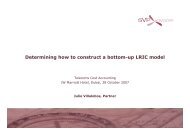ante Margin Squeeze Test
ante Margin Squeeze Test
ante Margin Squeeze Test
You also want an ePaper? Increase the reach of your titles
YUMPU automatically turns print PDFs into web optimized ePapers that Google loves.
<strong>Margin</strong> squeeze test:methodology<br />
Where ∆P represents the increase in price for the bundle compared with the price of<br />
the core service - that is, the increase in price associated with the inclusion of the<br />
service in the bundle. ∆CW, ∆CR, ∆CM and ∆M represent respectively the increase<br />
in wholesale costs, the increase in retail costs and increase of margin associated<br />
with the inclusion of the new service in the bundle.<br />
Recommended approach<br />
By comparing the two tests, the joint replicability test combines a more intelligible<br />
approach with a lesser need to assume or manipulate factors to determine costs<br />
and revenues. The single test, moreover, can provide robust results only if an<br />
increment within the bundle has been clearly identified. Furthermore, the<br />
incumbent and alternative operators in question do not currently have cost and<br />
revenue information at the appropriate level necessary for performing single tests.<br />
Taking into consideration these opinions and through careful reflection on the<br />
specific regulatory conditions and objectives of NITA, described in section two, the<br />
joint replicability test is recommended as a sound choice.<br />
© SVP ADVISORS P a g e | 14<br />
June 2009



